Related Research Articles

Der Stürmer was a weekly German tabloid-format newspaper published from 1923 to the end of World War II by Julius Streicher, the Gauleiter of Franconia, with brief suspensions in publication due to legal difficulties. It was a significant part of Nazi propaganda, and was virulently anti-Semitic. The paper was not an official publication of the Nazi Party, but was published privately by Streicher. For this reason, the paper did not display the Nazi Party swastika in its logo.
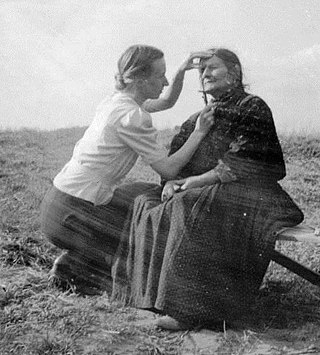
The racial policy of Nazi Germany was a set of policies and laws implemented in Nazi Germany under the dictatorship of Adolf Hitler, based on pseudoscientific and racist doctrines asserting the superiority of the putative "Aryan race", which claimed scientific legitimacy. This was combined with a eugenics program that aimed for "racial hygiene" by compulsory sterilization and extermination of those who they saw as Untermenschen ("sub-humans"), which culminated in the Holocaust.

The Reich Security Main Office was an organization under Heinrich Himmler in his dual capacity as Chef der Deutschen Polizei and Reichsführer-SS, the head of the Nazi Party's Schutzstaffel (SS). The organization's stated duty was to fight all "enemies of the Reich" inside and outside the borders of Nazi Germany.
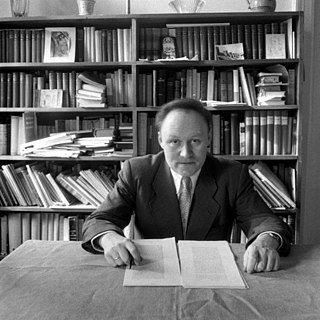
Friedrich Heer was an Austrian historian born in Vienna.

Victor Klemperer was a German scholar who also became known as a diarist. His journals, published in Germany in 1995, detailed his life under the German Empire, the Weimar Republic, the Fascist Third Reich, and the communist German Democratic Republic.
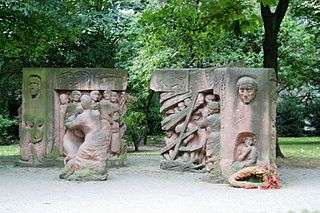
The Rosenstrasseprotest is considered to be a significant event in German history as it is the only mass public demonstration by Germans in the Third Reich against the deportation of Jews. The protest on Rosenstraße took place in Berlin during February and March 1943. This demonstration was initiated and sustained by the non-Jewish wives and relatives of Jewish men and Mischlinge,. Their husbands had been targeted for deportation, based on the racial policy of Nazi Germany, and detained in the Jewish community house on Rosenstrasse. The protests, which occurred over the course of seven days, continued until the men being held were released by the Gestapo. The protest by the women of the Rosenstrasse led to the release of approximately 1,800 Berlin Jews.

Werner Goldberg was a German of half Jewish ancestry, or Mischling in Nazi terminology, who served briefly as a soldier during World War II. His image appeared in the Berliner Tageblatt as "The Ideal German Soldier", and was later used in recruitment posters and propaganda for the Wehrmacht.

Karl Rudolf Werner Best was a German jurist, police chief, SS-Obergruppenführer, Nazi Party leader, and theoretician from Darmstadt. He was the first chief of Department 1 of the Gestapo, Nazi Germany's secret police, and initiated a registry of all Jews in Germany. As a deputy of SS-Obergruppenführer Reinhard Heydrich, he organized the World War II SS-Einsatzgruppen, paramilitary death squads that carried out mass-murder in Nazi-occupied territories.
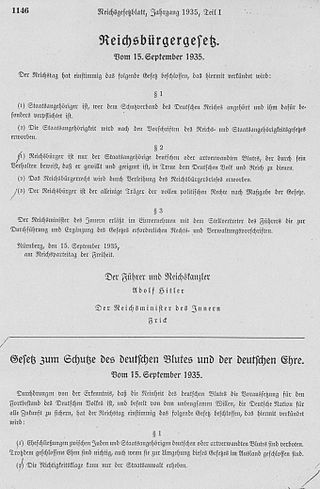
Rassenschande or Blutschande was an anti-miscegenation concept in Nazi German racial policy, pertaining to sexual relations between Aryans and non-Aryans. It was put into practice by policies like the Aryan certificate requirement, and later by anti-miscegenation laws such as the Nuremberg Laws, adopted unanimously by the Reichstag on 15 September 1935. Initially, these laws referred predominantly to relations between ethnic Germans and non-Aryans, regardless of citizenship. In the early stages the culprits were targeted informally; later, they were punished systematically and legally.
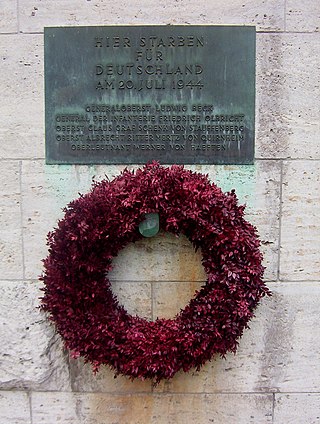
Many individuals and groups in Germany that were opposed to the Nazi regime engaged in resistance, including attempts to assassinate Adolf Hitler or to overthrow his regime.
Max Naumann was the founder of Verband nationaldeutscher Juden, which called for the elimination of Jewish ethnic identity through Jewish assimilation. The league was outlawed by the Nazi government on 18 November 1935.
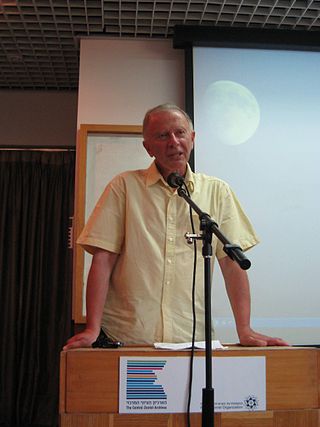
Robert Solomon Wistrich was a scholar of antisemitism, considered one of the world's foremost authorities on antisemitism.
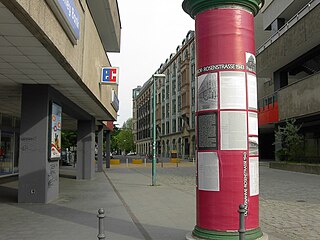
Fabrikaktion is the term for the last major roundup of Jews for deportation from Berlin, which began on 27 February 1943, and ended about a week later. Most of the remaining Jews were working at Berlin plants or for the Jewish welfare organization. The term Fabrikaktion was coined by survivors after World War II; the Gestapo had designated the plan Große Fabrik-Aktion. While the plan was not restricted to Berlin, it later became most notable for catalyzing the Rosenstrasse protest, the only mass public demonstration of German citizens which contested the Nazi government's deportation of the Jews.
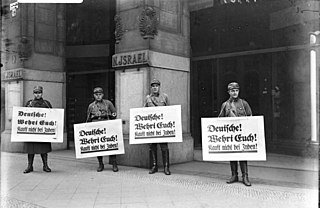
The Nazi boycott of Jewish businesses in Germany began on April 1, 1933, and was claimed to be a defensive reaction to the anti-Nazi boycott, which had been initiated in March 1933. It was largely unsuccessful, as the German population continued to use Jewish businesses, but revealed the intent of the Nazis to undermine the viability of Jews in Germany.

The anti-Nazi boycott was an international boycott of German products in response to violence and harassment by members of Adolf Hitler's Nazi Party against Jews following his appointment as Chancellor of Germany on January 30, 1933. Examples of Nazi violence and harassment included placing and throwing stink bombs, picketing, shopper intimidation, humiliation and assaults. The boycott was spearheaded by some Jewish organizations but opposed by others.
Secondary antisemitism is a distinct form of antisemitism which is said to have appeared after the end of World War II. Secondary antisemitism is often explained as being caused by the Holocaust, as opposed to existing in spite of it. One frequently quoted formulation of the concept, first published in Henryk M. Broder's 1986 book Der Ewige Antisemit, stems from the Israeli psychiatrist Zvi Rex, who once remarked: "The Germans will never forgive the Jews for Auschwitz." The term was coined by Peter Schönbach, a Frankfurt School co-worker of Theodor W. Adorno and Max Horkheimer, based on their critical theory.
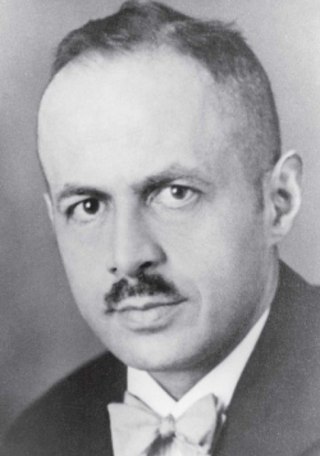
(Georg) Friedrich Weißler was a German lawyer and judge. Born into a Jewish family and baptized Protestant, he joined the Christian resistance against the Nazi regime after Nazi bullies had destroyed his judicial career.
Anti-miscegenation laws are laws that enforce racial segregation at the level of marriage and intimate relationships by criminalizing interracial marriage and sometimes, they also criminalize sex between members of different races.

Gustav Adolf Nosske was a German lawyer and SS-Obersturmbannführer. In 1941–42, he commanded Einsatzkommando 12 within Einsatzgruppe D, under the command of Otto Ohlendorf. Tried in the Einsatzgruppen Trial in 1948, Nosske was sentenced to life imprisonment. He was released early in December 1951.
The German Vanguard: German Jewish Followers was a German association of pro-National Socialist Jewish Germans. It was founded in February 1933 by the historian of religion Hans-Joachim Schoeps and dissolved in December 1935.
References
- ↑ https://www.jns.org/the-perfidious-among-us-past-and-present/
- 1 2 Sarah Ann Gordon, Hitler, Germans, and the "Jewish Question", p. 47
- ↑ (in German) M. Hambrock, Die Etablierung der Aussenseiter. Der Verband nationaldeutscher Juden 1921–1935, p. 367
- 1 2 3 Robert S. Wistrich, Who's Who in Nazi Germany (London: Weidenfeld and Nicolson, 1982), p. 177. ISBN 0-297-78109-X
- ↑ (in German) M. Zimmermann, Geschichte des deutschen Judentums 1914–1945, p. 32
- ↑ (in German) M. Hambrock, Die Etablierung der Aussenseiter. Der Verband nationaldeutscher Juden 1921–1935, p. 590ff.
- ↑ N. Stoltzfus. Resistance of the Heart: Intermarriage and the Rosenstrasse Protest in Nazi Germany. p. 315.
- ↑ Anonymous review of Robert Gessner's book Some of My Best Friends Are Jews in Literary Digest (New York), December 19, 1936, p. 81; M. Hambrock
- ↑ Hambrock, M. "Der Verband nationaldeutscher Juden 1921–1935". Die Etablierung der Aussenseiter: 578. JSTOR 20741334.